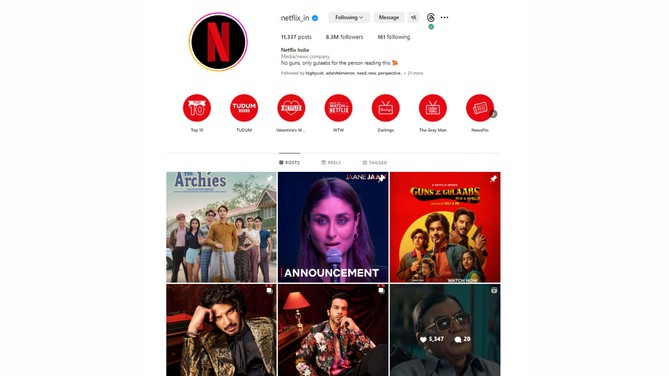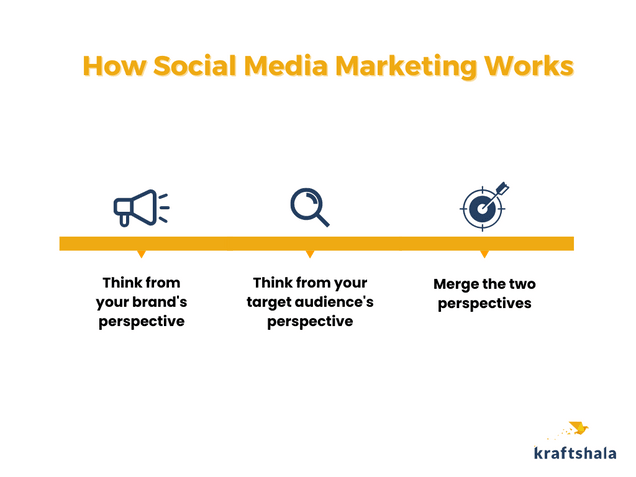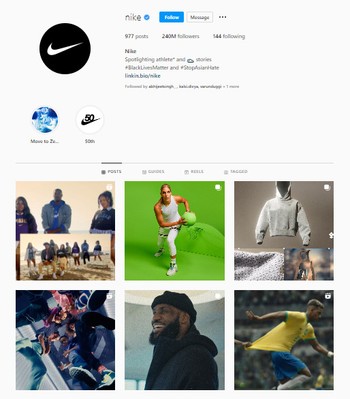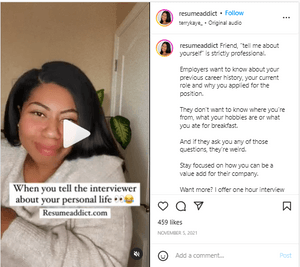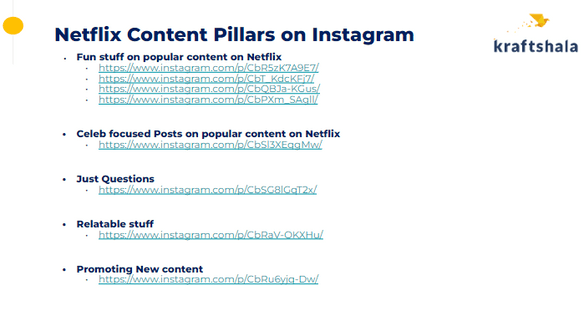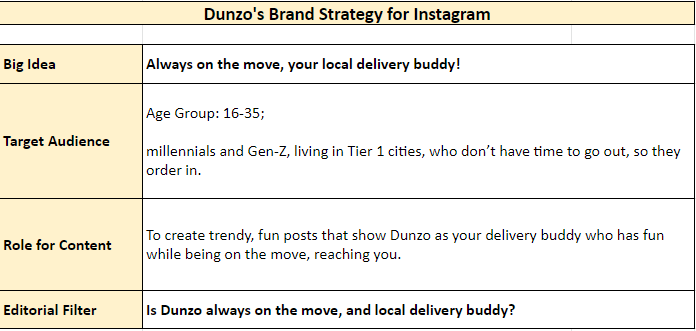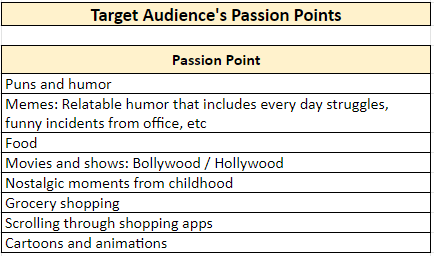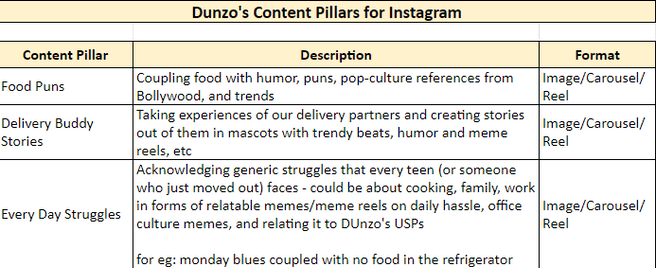How to Create a Kickass Social Media Marketing Strategy Like Netflix?
Table of contents
- Key Takeaways from the Blog
- How to Create a Social Media Marketing Strategy?
- Define Your Brand Communication – There Are 4 Steps to It
- Think from Your Audience’s POV to Understand What They Could be Passionate About – Their Passion Points
- Merge The Two Perspectives – Create Your Content Pillars Using All the Information
- Can This Social Media Marketing Strategy Work for Any Brand?
- Frequently Asked Questions
With 8.3 million followers, and an average likes of 50K on all posts on Netflix India’s Instagram Page, you might be wondering what social media marketing strategy must Netflix follow to stand out. What do they do differently?
Hear us out! This blog is here to help you figure that out and to help you create your own social media marketing strategy for any brand.
Key Takeaways from the Blog
This blog will help you create your go-to social media marketing strategy to help build any brand’s social media presence like Netflix.
What this blog covers:
- What is social media marketing?
- Defining your brand communication to determine what is your big idea.
- Understanding who your target audience is
- Defining how the content should ideally serve your audience – aka the role of content
- Creating an Editorial Filter – the benchmark your posts should meet
- Thinking from your audience’s POV to understand what they could be passionate about
- Creating your content pillars using all the information
What is Social Media Marketing?
Have a look at Netflix India’s Instagram. What does it make you feel?
To me, it feels like we’re at the right place to be entertained (hold on to this word) by the best pop culture references. Not only that, but Netflix India’s Instagram Page has also become the go-to place for ‘what to watch next’ recommendations.
If you’ve felt the same, it’s because Netflix wants you to feel that. It is how they’ve developed their personality on Instagram.
Social Media Marketing helps build brand awareness and get your target audience to know about your brand through posts. But that’s not all.
You see, just remembering your brand name isn’t enough (that’s awareness). It’s like someone knowing your name just for the sake of it. Brands want you to remember something about them.
For example, Nike wants you to think of them as this inspirational brand that pushes you to take the leap and just do things in life.
Dettol wants to be all about protecting you from harmful germs.
And just like that, Nescafe wants to be about fastening the pace of your life and helping you want more from life.
You’ll notice a pattern here. These brands want to be associated with an emotion that humanizes them and connects them to their target audience. This way, their audience remembers them the next time they want something that feels remotely similar to what any of these brands offer.
Social media marketing is one good way to amplify this emotion that relates your brand to your target audience. Your audience then remembers you and recalls your brand through your posts.
Outcome: You attain top-of-the-mind brand awareness.
Now the question arises, how do you do that?
How to Create a Social Media Marketing Strategy?
Jeff Bezos says,
“Your brand is what other people say about you when you’re not in the room.”
So, when you devise a brand strategy for social media marketing, you set the tone of how you want to be perceived by others. In Jeff Bezos’ words, building a brand strategy lets you control what people are talking about you when you aren’t in the room.
In today’s era of building a brand and taking off to the digital world, you’ll find almost every other brand, big or small, trying to make a mark on social media, keeping up with trends, and often getting lost in the noise.
So what about the brands, like Netflix, that stand out amidst all the noise?
What you’ll find common to brands like Netflix standing out on social media is that they’ve mastered the art of understanding their target audience. This is how they meet their needs.
But is that it? Nope.
Let’s take Taylor Swift. Her brand identity is as consistent as ever. She delivers bangers out of songs that her audience relates hard to and cries for. But, she has not only catered to her target audience’s needs.
Throughout her music career, she has stayed true to herself and her experiences. She knows who she is, and what she wants to put out for the world to see – in terms of her interactions with her audience, her songs, her experiences, everything.
How?
Taylor Swift came up with her true brand voice by identifying her goals.
Who am I speaking to? What am I communicating? How am I viewed? What should I do to maintain the tone and grow my audience at the same time?
These were some questions that pondered over her mind, which helped her become the brand she is today.
Define Your Brand Communication – There Are 4 Steps to It
Step 1: Create Your Brand’s Big Idea
Your big idea comprises stories, history, and the people you want to cater to.
Determine what is the one thing that holds true for your brand. It can be an aspirational mission that your brand is trying to solve. It should answer, “This is what my brand stands for”. Simple, relevant to your audience, and often emotional.
The big idea should have a purpose that people relate to and answer why they should care about your brand.
Let’s go back to Netflix’s example.
Netflix has been clear with its communication objectives since the start. Even when they sold DVDs, they were clear that they wanted to entertain the world. Their streaming service started, social media became popular and now their every other post goes viral with this same objective that they want to entertain the world, the world being their audience.
Hence, Netflix’s big idea for social media is – “We want to entertain the world”.
As for Kraftshala, we’re an ed-tech organization. Our approach to educating young graduates helps them land their careers in marketing. We’re obsessed with helping young people upskill in the field of marketing.
And so, our big idea is – Education That Gets You Hired.
Step 2: Understand Who Is Your Target Audience
Now that you know what your brands stand for, who should you be targeting?
For Netflix, it is people who are young college goers, millennials, and tech-savvy people who want to be entertained and updated with the latest shows, and movies to watch.
So, when you determine your audience for your social media, think along these lines:
- How does the audience feel and behave online?
- What do they do online that is relevant to your brand and big idea? Maybe they binge on memes and like to scroll through reels. Anything.
But it’s social media, right? Everyone can see your post. The more the merrier then? In case you’re wondering along these lines –
Think of the brand as YOU. YOU do not connect with everyone in the world, right? That’s exactly why we need a target audience that gets us.
Simply put, targeting the right audience makes sure that your social media marketing is optimized and that all your brand communication reaches the people who need it and will appreciate your posts.
Step 3: Define How the Content Should Ideally Serve Your Audience – aka The Role of Content
Netflix has made its mission to entertain the world. The big idea says it and their social media says it. In fact, every post of theirs serves the purpose of entertainment. The new launch of a movie on Instagram? Hella entertaining.
It’s almost as if you think of Netflix and you are reminded of entertainment because their brand communication is that consistent.
How, though?
They maintain this consistency through – their role in content.
Say an Instagram user follows your brand for a week and has seen 5-10 posts of yours. Now, what do you want those posts to do for your brand in the mind of that user? Your ‘role for content’ decides that.
Remember when we talked about Nike for taking a leap of faith and just doing things? Dettol for protection and Nescafe for fastening the pace of your life and wanting more from life? They achieved consistency in their brand communication through role for content.
Think of the role of content as – the role your content plays in your audience’s minds.
For example, Netflix’s social media marketing goal is to build long-term relationships with its audience and drive more engagement. So they create content on trending topics that their followers engage with and show that people love and are talking about.
Netflix’s Role in Content is – To place Netflix as the most entertaining, iconic, and happening streaming app.
As for Kraftshala, we make India’s most loved marketing and sales training programs with one main objective: to get our students hired by top companies and agencies.
So Kraftshala’s Role for Content is – To place Kraftshala as a team that is obsessed and highly proficient at getting their students hired.
Step 4: Create an Editorial Filter – The Benchmark Your Posts Should Meet
Once you’ve decided your brand’s big idea and role for content, the editorial filter acts as the literal filter that lets you judge each post you create on the metrics of your brand objectives.
Like, Netflix wants engagement through entertaining content. If they create content around boring stuff, say mutual funds, first, it won’t align with their business (they offer a streaming service for god’s sake) and second, it won’t be entertaining to their audience because they follow Netflix for entertainment.
So, an editorial filter acts as a short-term guardrail that checks every post by the brand’s main communication objective (in Netflix’s case – entertainment) and decides if one should go ahead with the post.
Think along the lines of choosing which story to share on social media. Editorial filters are mostly posed as a question.
For example, Netflix’s possible editorial filter is – is it entertaining to the world?
Let’s circle back to Nike.
By this point, you know Nike wants to inspire people to just do things. How do you think they achieve their goal of communicating that with their target audience?
Look at their Instagram Page. You’ll find that they share stories of everyday athletes who are just winging it. Doing things by taking a leap of faith in them and striving.
Their editorial filter is right in place, helping them express themselves as who they are.
Now, guess what their editorial filter could be?
You guessed it! – “Does this reflect that they just do it?”
Think From Your Target Audience’s Perspective: Passion Points
You’ve seen how Netflix and Taylor Swift have stayed true to their brands while staying relevant to their target audience at the same time. They’ve maintained a balance in terms of staying true to their brand objectives while also delighting their target audience at the same time.
The reason why they’ve maintained that balance in their communication is simple, yet often ignored.
If you only stick to your brand strategy, while completely ignoring the people you want to communicate with, you lose out on making a mark. Fast forward to a few months, and your social media marketing game is dead.
There’s another extreme. If you only plan on delighting your target audience through their passion points, while completely losing focus on your brand strategy, you end up becoming a meme page. So, as you’ve now guessed, maintaining a balance is key to acing your social media marketing game.
So now, how do you delight your audience?
For instance, Taylor Swift.
She creates music out of her experiences, which are not too different from her target audience’s experiences. She speaks their language, and through her storytelling, she makes her fans question – ‘how does she know me so well?’.
This is no different from understanding your target audience well – who they are, what their interests are, what makes them tick, what brings them joy, and what some of their experiences could be.
Take our example again – Netflix.
It’s true that Netflix creates posts that entertain us, but how?
They have researched their target audience well. Like Taylor Swift, Netflix also knows what its audience cares about, and would like to engage with.
So, as we pair our social media posts with what might interest our target audience, we see things from their perspective. This way, we find our target audience’s passion points or triggers that make them feel.
Think from Your Audience’s POV to Understand What They Could be Passionate About – Their Passion Points
Passion points, as the name suggests, are things your audience finds interesting that they engage with. Including a passion point aligned with your target audience in your posts makes your content stand out, which your audience stares at for a while, and gasps, “damn, this is goooood”.
Outcome: Consumer delight and more engagement.
In Netflix’s case, its target audience is young people, millennials who work, tech-savvy people who want to stay updated with new shows and movies to watch, etc.
Now, a working professional, no matter how much they love their job, would still want to rest and would want a holiday. That necessity is a plethora of emotions running through their mind. Hence, relatability becomes a passion point.
We want entertainment – a fact. We want to watch something new. Hence, recommendations become another passion point.
We love memes. Always. About anything. This is another passion point.
And so on.
This way, determine passion points for your target audience through research.
- find what they’re searching online through social tools like Awario
- research their online behavior
- check the kind of social media trends that they resonate with
OR, there is another simple, old-fashioned way of finding out what your target audience likes – by meeting them and asking them what pages they follow. Understand why they follow these pages, and why these pages work. There are some passion points that these pages have that delight them.
When Kraftshala was just beginning their social media marketing on Instagram, they tried to understand their target audience’s passion points through this trick.
The image below is one such example of a post that their target audience engages with.
This post delights our target audience because it benefits them and helps them stay away from common interview mistakes, something that young graduates (Kraftshala’s TG) SHOULD know when they’re starting their marketing careers.
Merge The Two Perspectives – Create Your Content Pillars Using All the Information
Now that you’ve understood what brand strategy is, and how to create one, all you’re left to do is merge your target audience’s interests with your brand’s objectives and create content pillars.
For starters, content pillars are the overall content categories around which you create content. The pillars hold your social media marketing strategy in place, give structure, and deliver consistency in brand communication.
These content pillars are sets of themes that you can use for creating social media posts that help you connect with your audience while maintaining your brand’s tone, communication, and overall strategy.
For context, Netflix’s content pillars for Instagram are –
What you’ll see in these content pillars is that Netflix’s big idea, “We Want to Entertain The World” and their target audience’s passion points are merged into these content pillars.
Like, celeb-focused posts on popular content are always fun to watch. You want to know what’s happening behind those perfect scenes, in the celebs’ lives. Everybody likes a good laugh. Netflix knows that. This makes up for a content pillar that not only entertains its target audience but also humanizes the brand.
While these content pillars work for Netflix, they may not work for other brands. Hence, the content pillars you choose for your chosen brand should include your brand strategy, but your content strategy should also have your audience’s passion points.
And, once you’ve decided on the content pillars, you’ve decided on your content strategy. All you’re left to do is make a plan of which content pillar to go on which day of the week, create posts, engage with your audience, and grow!
Can This Social Media Marketing Strategy Work for Any Brand?
Now that you’ve understood how to make a social media marketing plan for a brand, let’s play.
Introducing – Dunzo.
An Indian product delivery startup founded in July 2014, Dunzo delivers anything you want, whenever you want. Whether you don’t want to go out, or can’t go out, it understands and has positioned itself to help you by delivering groceries, gifts to someone, food, laundry, and anything you ask, you get.
But there’s more to Dunzo than what meets the eye. We say that because of their exceptional social media presence, especially on Instagram. So, let’s pull out an Excel sheet and break down their social media marketing strategy for Instagram.
Starting with Dunzo’s Brand Strategy
Dunzo likes to have fun while being on the move. They want to be your go-to delivery partner that meets your needs with a little fun and a lot more cuteness!
And so their brand strategy on Instagram is –
Next Up, What Are Dunzo’s Target Audience’s Passion Points?
If you’ve not already guessed, Dunzo is here to have fun and make their target audience have fun at the same time. They’ve catered to some of their audience’s passion points, which are –
Last, Dunzo’s Content Pillars
So, now that we’ve created a brand strategy for Dunzo and have understood their target audience’s passion points, we merge these two perspectives into content pillars to create their social media marketing strategy.
Once you’ve created content pillars for Dunzo, you start creating posts catering to each of these content pillars and post them according to what seems to fit particular days of the week.
Frequently Asked Questions
Q.1 How did Netflix establish its unique brand voice through social media marketing?
Answer: Netflix’s distinctive brand voice on social media emerged by combining humor, relatable content, and pop culture references. This approach resonates with their audience, making them feel like they’re interacting with a friend rather than a corporation. By consistently infusing their content with this tone, Netflix humanizes its brand and forges a strong connection with users.
Q.2 What role does audience segmentation play in a successful social media strategy, similar to Netflix’s approach?
Answer: Audience segmentation is pivotal in emulating Netflix’s social media strategy. Just as Netflix tailors content based on viewer preferences, businesses should segment their audience into distinct groups based on demographics, interests, and behaviors. This enables targeted content creation and personalized engagement, enhancing the chances of resonating with each subgroup effectively.
Q.3 How can a content calendar contribute to a social media strategy’s success, drawing inspiration from Netflix?
Answer: Like Netflix’s well-planned release schedule for shows and movies, a content calendar helps maintain consistency and keep the audience engaged. By strategically planning and scheduling content, businesses can build anticipation, maintain a steady flow of updates, and prevent content fatigue, ultimately fostering a loyal and engaged online community.
Q.4 What lessons can be learned from Netflix’s interactive and responsive social media approach?
Answer: Netflix’s responsiveness on social media fosters genuine conversations and showcases a commitment to customer satisfaction. Brands aiming to replicate this should actively engage with their to audience by responding to comments, addressing concerns, and soliciting feedback. Such interactions establish a sense of authenticity, trust, and community around the brand.
Q.5 How can data-driven insights elevate a social media strategy’s effectiveness, inspired by Netflix’s data usage?
Answer: Just as Netflix analyzes viewership patterns to shape its content strategy, businesses can leverage data-driven insights to refine their social media approach. By monitoring metrics such as engagement rates, click-through rates, and audience demographics, brands can make informed decisions, optimize their content, and ensure that their strategy aligns with the preferences of their target audience.





